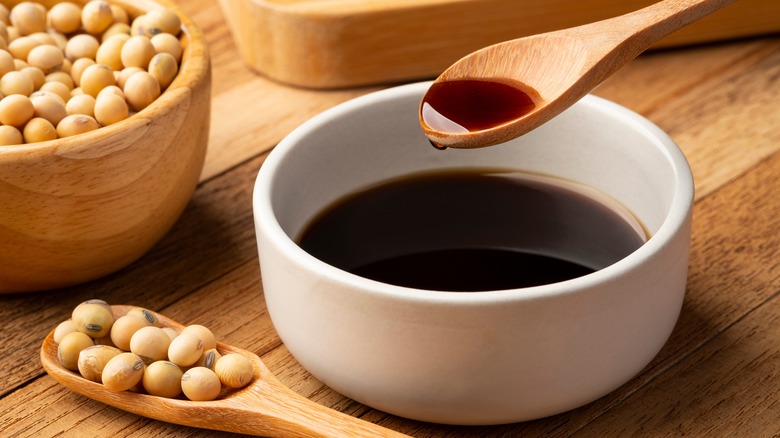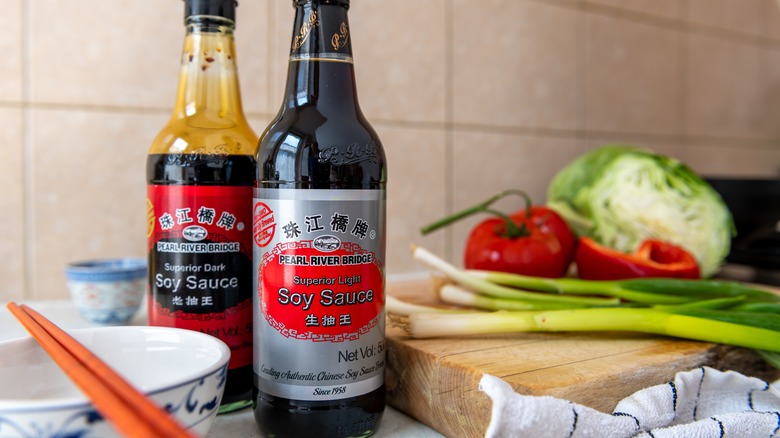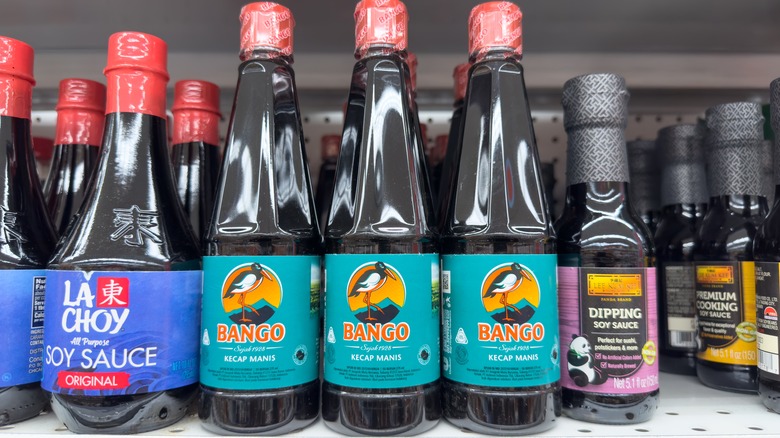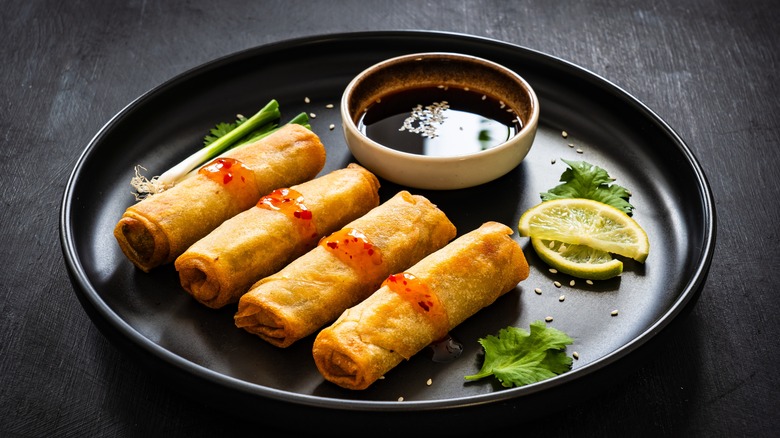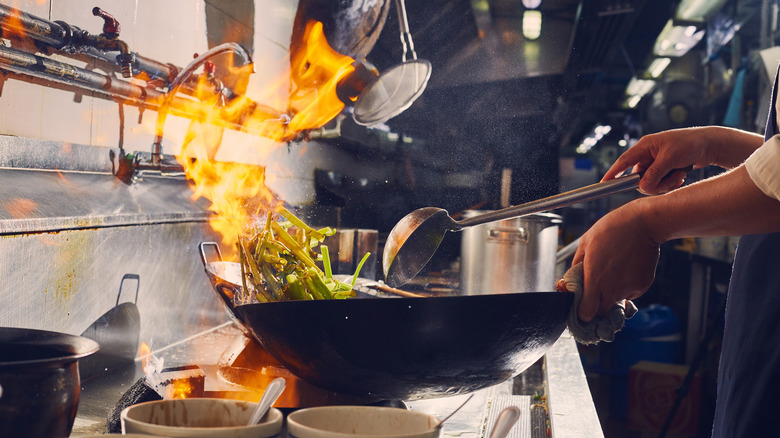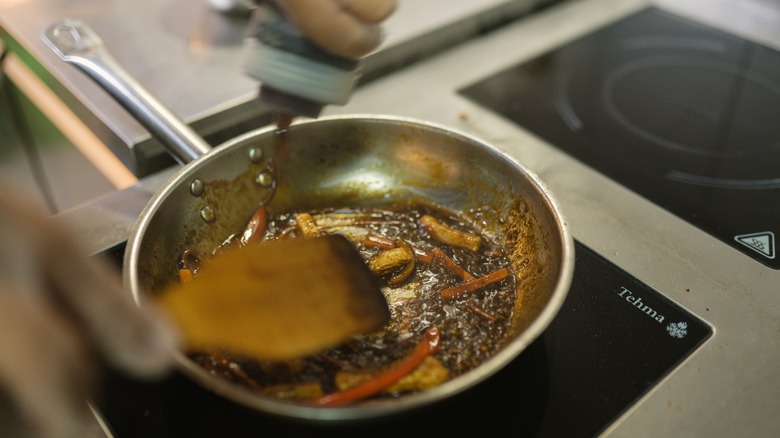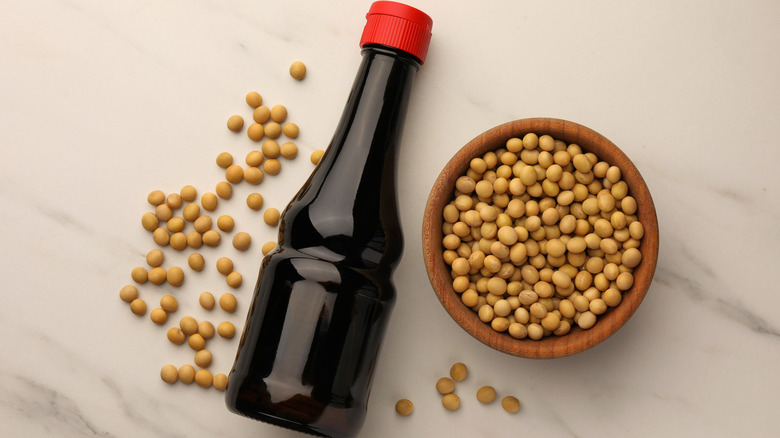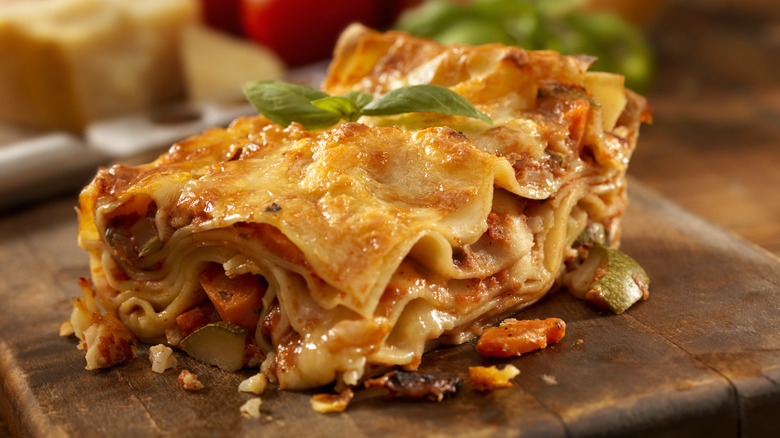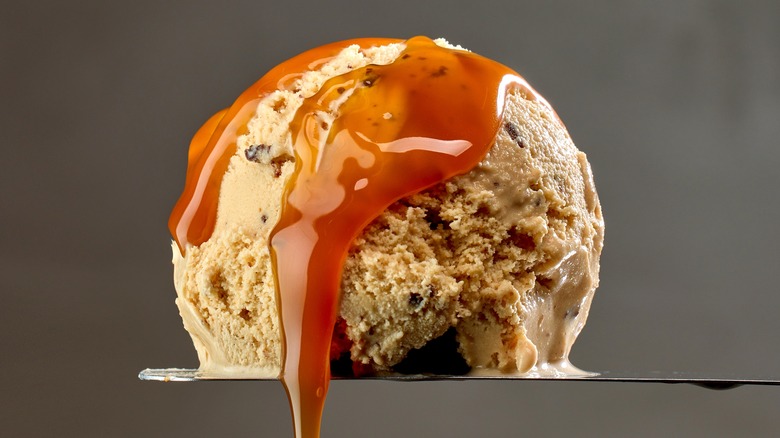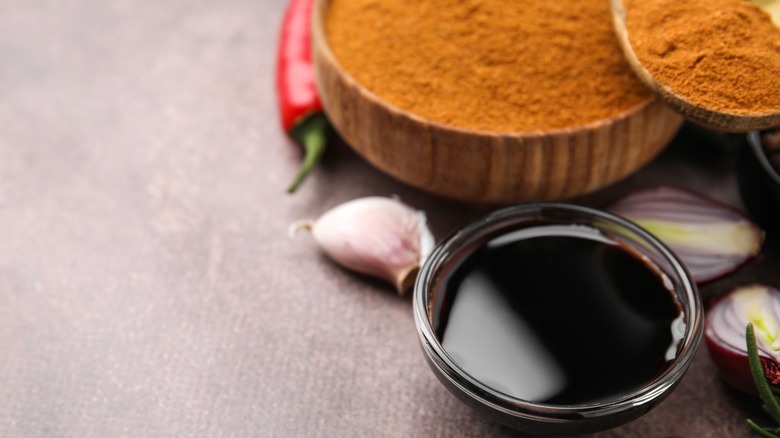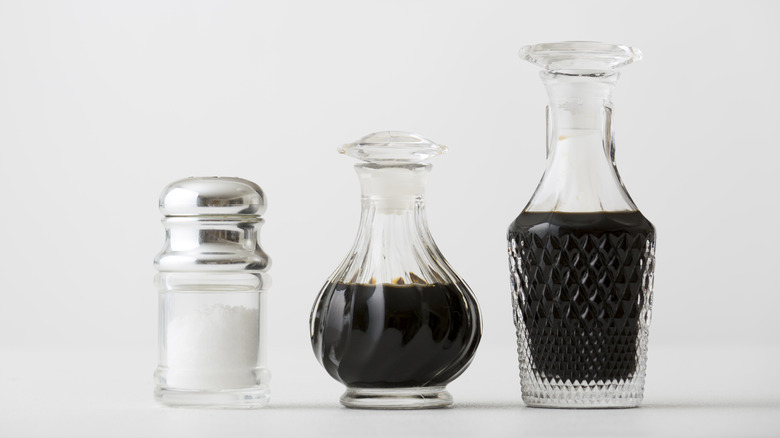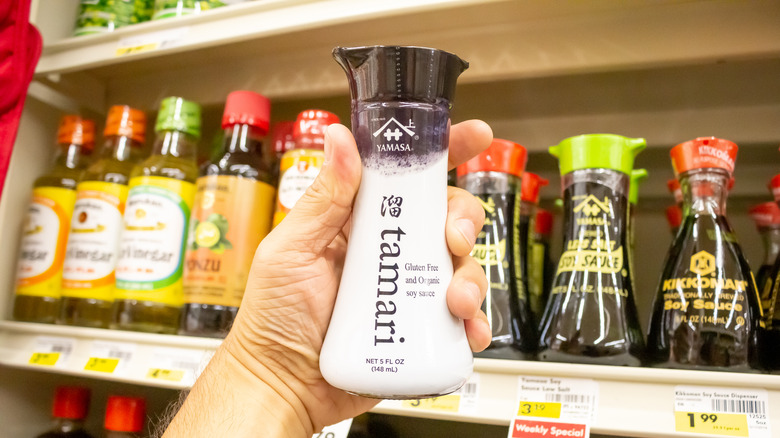Mistakes Experts Say You Should Never Make With Soy Sauce
The origins of soy sauce date back over 2,000 years — though it wasn't until the 13th century that it resembled the types we use today. However, it has a much shorter history in the U.S., which might be part of the reason why so many of us still make mistakes when cooking with soy sauce. Although it's a common ingredient, some folks don't understand the nuances of cooking with it. This can lead to people believing they don't like soy sauce or thinking they're just bad at cooking in general.
As a food writer and, frankly, obsessive cook, I'm no stranger to the ways of soy sauce. However, I wanted to get expert opinions from those with more experience. So, I interviewed three chefs and a food scientist so they could dish the dirt on soy sauce and the common errors people make with it. From the simple first mistake of not understanding the different types of soy sauce and the right one for the dish you're making to burning it or storing it wrong, there are all kinds of ways you can trip up. But, with these expert tips you'll learn the pitfalls to avoid and what to do instead.
Not learning the difference between light and dark soy sauce
If you're one of the many people who think that all soy sauce is the same, you're in for a rude awakening. "There are almost as many types of soy sauces as there are wines or vinegars," says food scientist Dr. Bryan Quoc Le. "Soy sauces are a very old condiment that has been around for thousands of years, and so the variations in them are extraordinary." Yet, so many home cooks just buy whatever soy sauce they come across at the store, not considering the variety.
At the very least, you might have heard of light and dark soy sauce. Buddha Lo — two-time Top Chef winner and executive chef at Hūso in New York — explains the difference. Dark soy sauce "is known for its dark, rich color and flavor." He adds, "I typically use it at the end of a stir fry or on noodles for a touch of color." He also uses dark soy sauce for braising meat. Light soy sauce, on the other hand, is "lighter in most aspects such as sodium, color and flavor," Lo says. "I use light soy for lighter marinades, broths, dashi and miso soup." He notes that it can also be added to food on the plate as a condiment, if it needs more seasoning.
Ignoring other types of soy sauce
We've covered light soy sauce and dark soy sauce, but this is just the tip of the iceberg. Light soy sauce and dark soy sauce are the main types of Chinese soy sauce, but then you have soy sauce from other countries.
"The major Japanese types of soy sauce are tamari, koikuchi, usukuchi, shiro shoyu, and saishikomi," says Dr. Bryan Quoc Le. "Koikuchi is the Japanese style of dark soy sauce while usukuchi is the Japanese style light soy sauce. Shiro shoyu is very light in flavor and is only lightly fermented, while saishikomi is a very sweet soy sauce that has a larger percentage of rice in its brewing process."
Vanda Asapahu, owner and head chef of Ayara Thai, points out that people often overlook the difference between Thai soy sauce and Chinese and Japanese versions. "Thai thin white soy is particular to Thai cooking," she says. "Thai soy sauce is distinct in flavor — often sweeter and lighter in color."
And, that's not where it ends. There are many other types, including Indonesian sweet soy sauce kecap manis, and Korean soy sauces joseon ganjang and yangjo ganjang. Overlooking all these soy sauce varieties means you aren't making the most of the distinct flavors they bring.
Using the wrong soy sauce for the dish
It's not just about knowing what soy sauces are out there but using the correct one for the dish you're making. "Different cuisines and recipes require certain soy sauce, and using the wrong type will alter the intended flavor of the dish," Chef Vanda Asapahu explains. So, if you've been throwing light soy sauce in a dish when a recipe calls for dark or using a basic soy sauce in place of a sweet one, like kecap manis, you're making a mistake.
If a recipe calls for a specific soy sauce, you should do your best to find the one listed. However, if this isn't possible, try to make sensible substitutions. For instance, when you don't have Japanese usukuchi, you could use Chinese light soy sauce. Or, if a recipe calls for sweet soy sauce, you could use dark soy sauce and brown sugar in a pinch. For recipes that don't specify a particular type of sauce, you should be fine using either light or dark, depending on how much richness and depth of flavor you're looking for.
Choosing the cheapest soy sauce at the store
Out of everything you need to know about soy sauce, it's important to remember that not every type or brand is equal. If you always pick the cheapest soy sauce at the store, you're not getting the best stuff around. We're not saying that you should always opt for the most expensive, just that you should make sure you're getting a quality option.
So, how do you pick a great soy sauce at the store? The first thing to consider is the difference between naturally brewed and chemical soy sauce. Traditionally, soy sauce is made by fermenting soybeans — this is the naturally brewed variety. However, you can also find chemical soy sauces that are made using hydrolyzed soy protein, colorings, and flavorings. These are best avoided. "The best soy sauces go through long-term fermentation processes that can last for several years," says Dr. Bryan Quoc Le. "These give authentic, rich flavors that only the microorganisms involved can produce."
If you're unsure how to find a good soy sauce, a good place to start is choosing a trusted brand. "Brands like Kikkoman, Lee Kum Kee, and Yamasa are known for quality," says Philippe Chow, owner and head chef of restaurant Philippe by Philippe Chow. "I usually stick with familiar brands such as Lee Kum Kee," remarks Chef Buddha Lo. "I've been using this brand for a very long time, and my father, who was a chef, would also use this in his cooking."
Burning soy sauce
It's easy to burn soy sauce when it hits a hot wok or frying pan. Since it's high in sugar, it can quickly caramelize and burn. It's not necessarily a bad taste. In fact, some people use the flavor of scorched soy sauce to elevate their recipes. However, if you're not looking for that particular flavor, it might leave you wondering what went wrong with your dish.
"Burning soy sauce can sometimes ruin the dish," says Vanda Asapahu. "To avoid this, when stir-frying, add it toward the end of the cooking process," she adds. She also notes that you should be extra careful with dark or sweet soy because it burns more quickly than thin and light varieties. Dr. Bryan Quoc Le has an alternative tip to avoid burning soy sauce. "It's best to add water or water-rich ingredients like rice wine or lemon to keep the soy sauce moist during the cooking process," he says.
Using too much or too little soy sauce
It's easy to use too much or too little soy sauce in a recipe. In fact, it's one of the most common mistakes people make with this ingredient. They're either too liberal when adding it or scared to be heavy-handed and go too far the other way. Both can cause your finished dish to not taste as good as it should. "Too much will make a dish too salty," says Chef Vanda Asapahu. While "too little might be under seasoned."
A dish with too much soy sauce might be inedible, while one that has too much in it will need some extra seasoning but is easier to fix, so it's best to err on the side of caution. If you're unsure how much to add, start with a little and gradually increase it. "The only way to avoid this common mistake is by continuously tasting as you go," remarks Buddha Lo. "When you are adding ingredients that will add salt you must add it slowly until you reach that desired umami flavor."
However, all's not lost if you accidentally add too much. "It's always easier to add than take out soy sauce, but if you add too much try watering it down with other ingredients you use for the recipe such as water or stock," says Lo. It might mean you have to make other adjustments to the dish, but it saves throwing it all in the trash.
Storing soy sauce incorrectly
You've probably been happily storing your soy sauce at room temperature, but that's not the best option. Although it's perfectly safe to keep it unrefrigerated, all four of our experts recommend storing it in the fridge to keep it at peak freshness and flavor for longer — and who are we to argue with that?
"Although soy sauce is so high in sodium that it will take quite some time to spoil, I still like to put any open bottle products in the fridge," Chef Buddha Lo remarks. And, there's a good reason for this. "Soy sauce should be refrigerated to slow down the oxidation process that can mute the flavors in the soy sauce," explains food scientist Dr. Bryan Quoc Le.
There's no need to worry if you usually store this ingredient in your pantry. Many people do. And some people still consider it the best way to store soy sauce. It's not going to kill you or even give you an upset stomach. It will just taste better if you store it in the fridge, especially if you get through it relatively slowly. So we'll be clearing some space in the refrigerator door to make room for our soy sauce collection from now on.
Only using soy sauce when cooking Asian cuisines
Soy sauce originated in China, by way of Japan and it's commonly used in a range of East Asian and Southeast Asian cuisines, including Thai, Indonesian, and Cambodian food. However, if you only ever use soy sauce when cooking dishes from or inspired by these regions, you're missing out. Soy sauce can lend its savory, umami notes to a wide range of dishes.
It's a huge mistake "not recognizing that soy sauce is versatile and belongs in every cuisine, not just Asian style dishes," says Buddha Lo. "Adding soy sauce to certain dishes in different cuisines elevates the dishes to a whole different level," he adds. So, maybe it's time to learn some more soy sauce recipes to expand your repertoire.
Where should you use soy sauce, aside from Asian dishes? Lo has some suggestions — "Why not add a splash of soy sauce to a matzah ball soup? Or add it to your marinara sauce? You will be shocked at how good it is when you do!" I like adding it to the sauce of a veggie lasagna to add an umami kick that can be lacking due to the missing meat. Chef Philippe Chow also recommends using it in salad dressings. It's worth experimenting and finding out where it works and where it doesn't.
Not using soy sauce in sweet dishes
It might sound strange, but you can use soy sauce in sweet dishes, too. Not experimenting is a mistake our experts seriously suggest you avoid. Of all the false facts about soy sauce, the idea that it can't be used for sweet applications is a big one. Just remember, soy sauce is salty, but it's not salt, so you can't just use it anywhere that you might use salt in a sweet recipe. Add a splash of soy sauce instead of a pinch of salt in your chocolate chip cookies and you probably won't get the results you were hoping for. But it can add umami notes and a surprising depth of flavor to dishes where that's a benefit.
"Recently, I had dark soy sauce on soft serve ice cream," says Vanda Asapahu. "It was life changing," she adds. "Tasted like a salty caramel sauce." And, that's not the last we hear about caramel. "Another way I like to use soy sauce is in making caramel sauce by adding soy sauce as the salt and then pouring it over a soft serve or ice cream," says Buddha Lo. Soy sauce can also add a savory richness to chocolate brownies that works surprisingly well.
Not trying soy sauce in drinks
Soy sauce in drinks? Surely not! Well, according to Dr. Bryan Quoc Le "soy sauce can be used in very small concentrations in coffee, chocolate, tea, or shakes to add a dark, rich umami to a drink and to pull back on the bitterness found naturally in these drinks." The idea of putting soy sauce in a chocolate milkshake might seem like an odd one, but you shouldn't knock it until you try it.
You don't want to add so much that the soy sauce flavor becomes obvious, but a little can accentuate other flavors. If you like salted caramel or chocolate chip cookies with flakes of sea salt on top, then you might like adding soy sauce to drinks. If you want to give it a try, the key is to start slowly. Add just a drop at first and go from there, increasing the amount in a careful, measured way. It's easy to go overboard and turn your coffee into something that tastes like you should dip sushi rolls into it.
Not using soy sauce as a marinade
Three of our four experts suggest using soy sauce as a marinade. So, if you're not making use of it in this way, you're missing out. It can bring a great depth of flavor to whatever ingredients you marinate in it. And, since it's a liquid, it easily mixes in with other ingredients and absorbs well. Unlike salt, you don't have to stir it well to make sure it dissolves with the other marinade ingredients and it's less of a hassle to use than stock — another common ingredient that brings saltiness to a marinade.
Dr. Bryan Quoc Le says that the "deep, rich flavors" of dark soy sauce makes it a perfect choice for marinades. "I use light soy for lighter marinades," Buddha Lo remarks. Philippe Chow also recommends light soy sauce for this purpose. It's good when you want saltiness without an overwhelmingly rich soy sauce flavor.
It's easy to make a basic marinade from soy sauce. We'd recommend mixing it with an acidic ingredient — such as lemon juice or rice vinegar — and something sweet, like sugar or honey. Then you can add additional seasonings depending on the flavor profile of the dish you're making. For instance, if you're making something Thai-inspired, you could add some chopped lemongrass and galangal, or for an Indian-inspired dish, you could add garam masala and chili flakes.
Using soy sauce as the only source of salt
Soy sauce has a salty flavor. So, it might seem to make sense to use soy sauce as the only source of saltiness in recipes. But, actually, this is a common error that's best avoided. Rather than just using soy sauce to make your dishes salty, often you'll also want to add salt, broth, or even MSG to a dish.
According to Chef Phillipe Chow "using soy sauce as a primary salt source" is a common mistake. He says that you should "use it to enhance flavors, not to replace salt entirely." If you just add soy sauce to a recipe as the only form of salt, you're going to get an intense flavor. Sometimes you just want a hint of soy sauce flavor and this is when you'll want to also use regular salt or get saltiness from a stock or broth.
The other problem with using soy sauce as the only form of salt is that it's more variable. "Some soy sauces have more or less salt, which impacts the taste," explains Dr. Bryan Quoc Le. So, you might not always get the level of saltiness that you want. However, with table salt or sea salt, you know exactly what you're getting so there are no surprises.
Ignoring the gluten in soy sauce
Many people don't know there's a sneaky ingredient hiding in soy sauce: gluten. Of course, this is totally fine if you — or the people you're cooking for — don't have an allergy or intolerance to gluten. But, if you're making food for someone who follows a gluten-free diet, you might unknowingly feed them something that would be bad for them.
Although soybeans are the major ingredient in soy sauce, most types are also brewed with wheat or barley, both of which contain gluten. Tamari is the exception to this. "Tamari is most known as the gluten-free version of soy sauce," says Buddha Lo. "While the original is made with wheat and soy, tamari is made from rice and soy," he explains. Dr. Bryan Quoc Le also notes that some "tamari uses only soybeans in its brewing process." So, if you or someone you're cooking for avoids gluten, you don't have to completely swear off soy sauce — just use tamari soy sauce instead.
